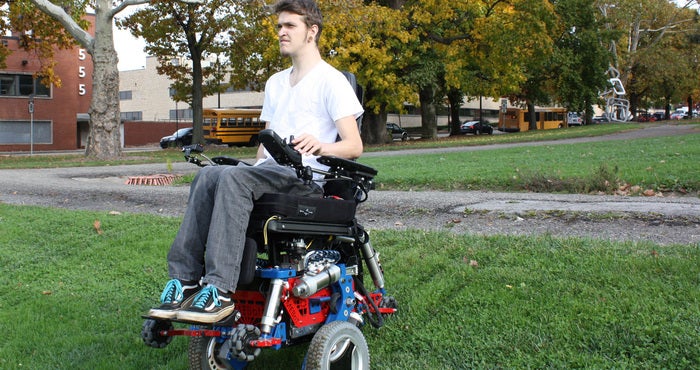
Subscribe to Pittwire Today
Get the most interesting and important stories from the University of Pittsburgh.Human Engineering Research Laboratories' MEBot Rolls Into Finals at Cybathlon
It was an international race like no other. In October 2016, designers, engineers and people with disabilities from around the world came together in Zurich, Switzerland, for the first-ever Cybathlon.
The race that pitted the latest assistive technologies against each other on a simulated course was thrilling in its own right. But the real excitement began when the wheelchairs crossed the finish line. That’s when discussions sparked between technology developers and people with disabilities, including conversations about how to bring advanced wheelchairs like these to market.
Graduate student researcher and School of Health and Rehabilitation Sciences (SHRS) PhD candidate Jorge Luis Candiotti (SHRS ’10) came to Cybathlon with MEBot, a revolutionary robotic-powered wheelchair developed at the SHRS Human Engineering Research Laboratories (HERL).
Candiotti was involved in the design, development, and testing of electronics and software to operate the various applications of MEBot. “I have been working on MEBot for the past five years,” he says. “The process involved a lot of feedback in the mechanical design and the incorporation of end-users’ comments and, of course, troubleshooting.”
At Cybathlon, MEBot competed against 12 other robotic wheelchairs in the power wheelchair division. Although it qualified for the finals, MEBot timed out of the final round.
“MEBot was among the crowd favorites and was clearly the front runner in commercial potential for indoor-outdoor use,” says Candiotti.
MEBot is unique because it features six independent, height-adjustable wheels. “The driving wheels are adjustable along its frame to change its driving configuration to mid-, front- or rear-wheel drive according to the environment and user’s preference,” says Candiotti.
“MEBot could climb over steps if necessary,” he adds. “In addition, the wheelchair can adjust the seat to a flat level when driving over uneven terrains or to prevent tips or falls.”
The organizers encouraged teams competing in the Cybathlon to also apply for the Blackwood Design Award. HERL submitted the MEBot and was selected as the winner.
“I’m very proud of the team working on the MEBot for its accomplishments at the Cybathlon, and for winning the Blackwood Design Award,” says Department of Rehabilitation Science and Technology Distinguished and FISA/PVA Chair Professor Rory Cooper, director of HERL.
This story first appeared in the Spring/Summer 2017 edition of the SHRS publication Facets.


